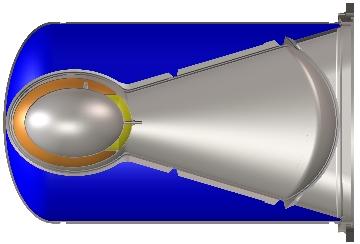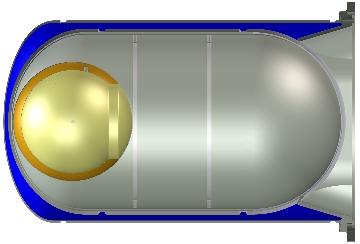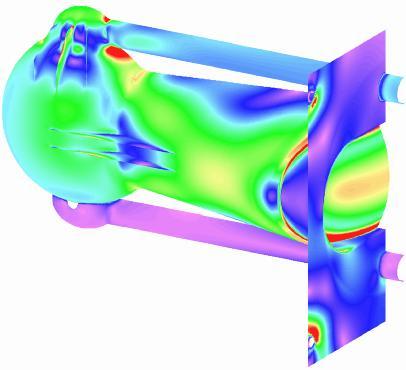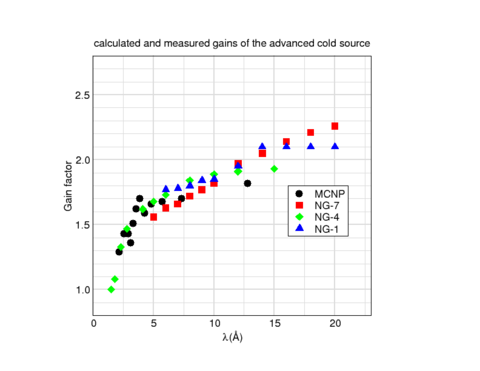The NCNR Advanced Cold Neutron Source
After six years of safe and reliable operation, the liquid hydrogen cold source cryostat has been replaced by one with a new advanced design. Conceptually based on our experience with the old cold source and optimized through extensive Monte Carlo simulations, the new source geometry greatly improves the neutron coupling of the source. Key differences between the old and new sources are illustrated in Fig. 1. The most important difference is the addition of 60 liters of D2O within the cryostat chamber, partially surrounding the moderator chamber.


Fig. 1. The original (bottom) and new (top) designs for the liquid hydrogen cold source cryostat. Heavy water volume is indicated in blue, liquid hydrogen in orange, and hydrogen vapor in yellow.
The shape of the new source is essentially an ellipsoidal shell, which is more difficult to fabricate but offers advantages over the spherical shape of the old source. The smaller volume of the ellipsoid allows more D2O to be introduced in the cryostat chamber. The center of the inner ellipsoid is offset, so that the liquid hydrogen shell is 30 mm thick near the source of neutrons, compared with 20 mm in the original source. The inner ellipsoid is evacuated, rather than hydrogen-vapor-filled as was the inner sphere of the old source. The geometry changes and the evacuation enhance the emerging neutron flux by another 15 to 20 %. An overall gain of 70-80% in cold neutron flux has been achieved, with specific gains depending on wavelength, ranging from 40% at 2.4 A to slightly more than 100% for wavelengths greater than 15 A.
The complex geometry of the advanced source posed many engineering challenges. The moderator chamber is surrounded by a vacuum vessel, which is in turn surrounded by a helium containment vessel strong enough to withstand the design basis accidental detonation of liquid hydrogen and solid oxygen. These vessels determine the extent of the D2O volume, surrounding the moderator chamber except for an opening just large enough to fully illuminate the neutron guides. This hour-glass shape created regions of very high mechanical stress, analyzed and eventually mitigated with the aid of finite element analysis (Fig. 2).

Fig. 2. False color representation of calculated stresses in the helium containment jacket at an internal pressure of 82 atmospheres.
The advanced cold source was placed into operation with the thermal neutron source running on March 6, 2002. Its performance is very close to predictions, to the delight of the designers and NCNR users. The gain factors in neutron flux of the new source relative to the original source were measured on instruments on several neutron guides as a function of neutron wavelength. The results are shown in Fig. 3, together with predicted values obtained with the Los Alamos "Monte Carlo N-Particle" (MCNP) code.

Fig. 3. Predicted (MCNP) and observed gains in neutron flux as a function of neutron wavelength.

